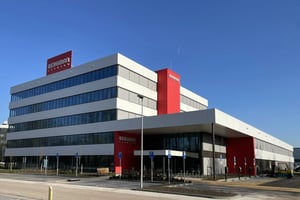This year marks the twentieth anniversary of the publication of Joe Pine’s ground-breaking book The Experience Economy. Ever since, businesses, retail companies and other organisations have been increasingly looking for ways to offer customers the highest level of customer experience and enhance their commitment to the brand, product or service. New technologies such as messaging, chatbots and AR (augmented reality) all play an increasingly important role in this omnichannel strategy (that is, including both online and offline media).
Includes comments from Davy Louwers, CEO of Fietsenwinkel.nl – an NPM Capital portfolio company.
Specialist e-bike retailer Fietsenwinkel.nl launched its own YouTube channel last year, which the company uses to post videos for instructional or entertainment purposes (‘We are not built to sit still’ being one of its taglines). The channel currently has 2,000 subscribers, which has measurably boosted sales and improved brand awareness.
Fietsenwinkel.nl is an excellent example of how businesses and other organisations use social media to forge closer emotional ties with potential and existing customers. Whereas old-school marketing (advertising, commercial, banners, etc.) was a one-way medium, today’s consumer communications are significantly more interactive, with customers able to comment instantly on a new video, write reviews, and so on. And the next trend is just around the corner, as experts believe consumer communications are slowly but surely migrating from social networks to messaging platforms such as WhatsApp, Facebook Messenger, Apple iMessage, Snapchat, Slack and WeChat: that is to say, from communications targeted at specific audiences or demographics to one-on-one communication.
The use of chatbots — computer programs designed to simulate direct communication with human users — has skyrocketed in recent years to keep all of this manageable. Chatbots rely on a machine-learning algorithm with natural language-processing capabilities, known as natural language processing (NLP). This natural language processing enables the bots to simulate human interaction, which involves learning from both the input data and from all the information they receive while ‘communicating’ with real people.
Real-time engagement
While just a few short years ago you could tell immediately when you were dealing with a chat box, the new generation of bots is becoming increasingly sophisticated, to the point where they virtually replicate the type of customer experience you would find in a regular shop. Being designed to simulate human responses in conversations, they can help customers select products and services, answer questions and offer customer care or after-sale services. Examples of chatbots already commonly used include Microsoft’s Cortana, Apple’s Siri, Amazon’s Alexa and Google’s Assistant.
Experts state that chatbots can facilitate active customer communications and boost real-time engagement among consumers. A perfect example of just how effective these next-generation digital experiences can be is KalaniBot, a branded bot modelled on the popular 19-year-old model and YouTuber Kalani Hilliker. The bot was created by the influencer marketing platform The Amplify, in association with chatbot development company Automat, and released for CoverGirl cosmetics in late 2016. KalaniBot currently has more than three million Instagram followers and ‘talks’ with fans about make-up, answers questions and provides information on special promotional campaigns. For CoverGirl, the bot’s most valuable asset are its metrics, including engagement levels and sales conversion rates for chatbot conversations. Chatbots are expected in the near future to be capable of conducting hundreds of intelligent conversations that closely match human interaction and will be able to attract and retain consumers in entirely new ways.
Improved brand experience or customer experience
A second, even more widespread method to tempt consumers and offer them a superior brand or customer experience is the use of AR. This revolutionary technology enables customers to make better purchasing decisions by visualising products. AR is currently used in the following five areas: store navigation, product information, product visualisation, virtual try-on and immersive marketing.
Although many customers still tend to prefer shopping at brick-and-mortar stores, many people have a hard time finding their way around large department stores or shopping centres. London-based start-up Blippar has created a solution to this problem in the form of an interactive, AR-based navigation tool that helps customers navigate large indoor spaces. As customers wander through a store, they are presented with AR images featuring product reviews and a selection of items for sale.
US retailer Walmart launched an AR-based feature in 2018 for its previously introduced smartphone app. When users tap their smartphone against a product’s barcode, an image appears of the product showing information such as price, reviews and links to related products. This feature, which is available for the iPhone 6S and newer models, makes the retail experience more efficient, more interesting and more enjoyable, says Tim Sears, Senior Engineering Manager at Walmart Labs.
Virtual try-on
AR is also perfect for viewing products online in the user’s own familiar environment. Dutch e-retailer Coolblue created an AR solution which allows customers to integrate a TV set into their home to see if the selected size suits their interior or fits onto a particular piece of furniture. This is part of the company’s efforts to reduce the high rate of return shipments.
Warby Parker, a US-based online retailer of prescription glasses and sunglasses, has also been experimenting with AR, having recently developed a new tool designed to help customers select a pair of glasses using their smartphones to check right away whether it is a good fit for their face shape and so on.
Sportswear brand Adidas entered into a partnership with social-media platform Snapchat: users can virtually try on the newest running shoes from the Adidas collection using the AR Lens. As with Coolblue’s solution, the underlying notion is that, if customers have a good idea of what their trainers look like when they are actually wearing them, they are less likely to return them to the retailer.
Arguably the most spectacular use of AR was pioneered by the French luxury fashion brand Balmain: the company uses technology to immerse customers (known as the ‘Balmain Army’) into Balmain’s exclusive world. Customers can use the AR app, for example, to live-stream fashion shows and other events and take a virtual tour of the recently opened flagship store in Paris. According to Balmain creative director Olivier Rousteing, the app is part of the company’s larger goal of making high fashion more accessible and inclusive to a wider group of people.
Blurring lines
Overall, we can state that new technologies will be used increasingly in the years to come to enrich the online and offline customer journeys with experiences that resonate with individual customers. Some of these technologies will be AI-driven, causing the traditional line between online and offline customer experiences to become more blurred. Or, as Suitsupply CEO Fokke de Jong puts it: “The gap between online and offline will narrow even further in the future, and technology will be the main driver in this process.”
Davy Louwers, CEO of Fietsenwinkel.nl:
“We use YouTube very strategically, as a complement to traditional above-the-line communications such as TV adverts. YouTube gives us the opportunity to tell people more about ourselves and what we’re all about and to connect with our target audience in a more personalised and impactful way. We actually tested this, and found that YouTube scores higher among certain demographics than traditional media, both in terms of reach and in terms of brand-awareness uplift.”
“We have been increasingly using WhatsApp and Facebook Messenger to connect with our customers. Two years ago, phone and e-mail still accounted for 40% and 60% of all customer communications, respectively. Today, more than 50% of all communications are conducted through Facebook Messenger and WhatsApp. You see, texting is a far more effective means of communication than calling, as it’s a lot more direct. At the same time, the style of communication is more asynchronous, which means a call-centre worker can handle two or three chats simultaneously, rather than talking to just one customer at a time. Many types of customer communications can be easily automated, which is, in fact, what we’re in the process of doing right now. I’ll give you one example: if a customer wants to change a service appointment in the store, the system can handle this 95 of the time, and all the employee needs to do is to check if the information was interpreted correctly. If this is the case, the system will do the rest. We have a pretty good idea by now of the topics our customers want to talk to us about, and I expect the system will be used to gradually manage more customer communications through the use of smart chatbots.”
“The use of AR is highly relevant to bicycles, as there are many different configurations for consumers to choose from: sizes, colours, wheels, accessories, and so on and so forth. We are currently working with another company on creating an AR tool that enables customers to see every imaginable configuration displayed on the screen.”
“At Fietsenwinkel.nl, connecting with customers is at the heart of everything we do. As bicycles in general —and e-bikes in particular — are very high-maintenance products, we don’t just sell a bike to a customer in a one-off transaction; we also sell years of service for that bicycle. That’s why engaging with our customers is the new standard at our company.”
Also read: ‘AI to become the ‘new normal’’













